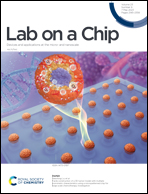Graphene-based microfluidic perforated microelectrode arrays for retinal electrophysiological studies†
Abstract
Perforated microelectrode arrays (pMEAs) have become essential tools for ex vivo retinal electrophysiological studies. pMEAs increase the nutrient supply to the explant and alleviate the accentuated curvature of the retina, allowing for long-term culture and intimate contacts between the retina and electrodes for electrophysiological measurements. However, commercial pMEAs are not compatible with in situ high-resolution optical imaging and lack the capability of controlling the local microenvironment, which are highly desirable features for relating function to anatomy and probing physiological and pathological mechanisms in retina. Here we report on microfluidic pMEAs (μpMEAs) that combine transparent graphene electrodes and the capability of locally delivering chemical stimulation. We demonstrate the potential of μpMEAs by measuring the electrical response of ganglion cells to locally delivered high K+ stimulation under controlled microenvironments. Importantly, the capability for high-resolution confocal imaging of the retina tissue on top of the graphene electrodes allows for further analyses of the electrical signal source. The new capabilities provided by μpMEAs could allow for retinal electrophysiology assays to address key questions in retinal circuitry studies.



 Please wait while we load your content...
Please wait while we load your content...